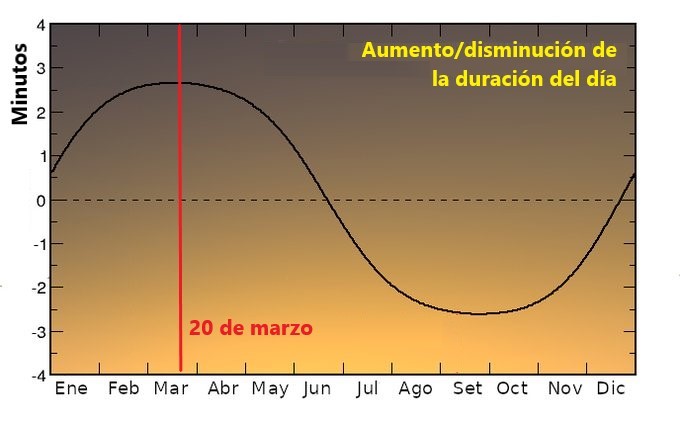Spring begins this Monday 20th at 22.24 (peninsular time). Two eclipses, planetary conjunctions, shooting stars, the station will be full of astronomical phenomena that can be enjoyed with the naked eye.
Longer days. Spring in the Northern Hemisphere (and autumn in the South) will begin on Monday, March 20 at 22.24 CET (21.24 in the Canary Islands).
Changing date. The beginning of spring changes from year to year. The date can be March 19, 20 or 21. In the twenty-first century, 2003 had the latest start of spring while 2096 will have the earliest start.
The days get longer. The beginning of spring is the time of year when the days get longer quickly: almost three minutes a day. In approximate terms, each day the Sun rises a minute and a half earlier and sets a minute and a half later than the day before.
Variation of daytime hours throughout the year. NAO/RB
Easter. The first full moon of spring determines the date of Holy Week. The rule is that Easter Sunday is the first Sunday following the first full moon of spring. In the case of this year, as the first full moon takes place on April 6, Easter Sunday will be the 9th of the same month.
Time change. Following the guidelines of the European Commission, the change to daylight saving time occurs on the last Sunday of March. Therefore, at 02.00 in the morning of March 26 (peninsular time) the clocks will have to be advanced until 03.00. This Sunday you will only have 23 hours. This time change, together with the lengthening of the days, will make us have much more time with sunlight during the afternoons.
Two eclipses. This spring brings us two eclipses, but neither of them is observable from Spain. On April 20, a solar eclipse will take place that will be visible as mixed from Indonesia, Australia and Papua New Guinea, and as partial from Southeast Asia, Australia, the Philippines and New Zealand. A penumbral lunar eclipse observable from Africa, Asia and Australia will also occur.
Planetary conjunction, twilight of April 11. Stellarim/RB
Planets. At sunrises this spring, we will be able to observe Saturn as a morning star, which Jupiter will join from mid-May. After sunset, we will see Venus and Mars. Mercury will make brief appearances at sunrises from late March to late April; It will form a beautiful conjunction with Venus, which will be located near the Pleiades, on April 11 (see attached illustration). Afterward, Mercury will be seen again in the evenings from mid-May to mid-June.
Shooting stars. The most interesting meteor showers of this spring are the Lyrids, which will reach their maximum activity around April 22, almost without the Moon, since the novilunio will have taken place on the 20th. The Eta Aquarids, also tend to constitute an abundant rain, but this year is not favorable for its observation because they will have their maximum on May 6 with the Moon practically full (the full moon will have been the day before).
At the Aries point. At the equinox the two poles of the Earth are at the same distance from the Sun. On that day, the Sun as seen from Earth is at Point Aries, crossing the celestial equator to the north. On the day of the equinox, at all points on Earth, except in the polar regions, the night has a duration equal to that of the day: 12 hours. Hence the word 'equinox' because, in Latin, 'aequi noctium' means 'equal night'.
And at the end, summer. This spring, which will last 92 days and 18 hours, will end on June 21 with the beginning of summer.
Rafael Bachiller is director of the National Astronomical Observatory (National Geographic Institute) and academician of the Royal Academy of Doctors of Spain.
According to The Trust Project criteria
Learn more
- Astronomy

